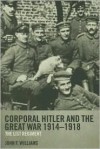Currently reading
"THE NAVY MADE A MAN OUT OF ME"

Written in response to a question from his grandson as to what did he do in the War, the author (Lon Perry Dawson), shares with the reader many of the experiences he had as a sailor in the U.S. Navy between 1941 and 1945.
Dawson was a 17 year old young man living in Chicago with his grandmother. It was the early spring of 1941. He was fresh out of high school and at a loss what to do with his life when he decided to join the military. He first had meant to join the Army, and had gone to the local recruiting office, which didn't impress him very much. The sergeant in the recruiting office told him that because he was underage (18 was then the minimum acceptable age for enlistment), he would need his parents' permission. (Dawson's parents had divorced when he was a boy and lived in separate residences some distance from where he lived with his grandmother with whom he was especially close.) So, Dawson went back home to talk to his family about his plans. After some discussion, he was allowed to join the Army.
Then fate intervened in the form of a young man Dawson had known in the neighborhood for several years. In Dawson's words: "We had a lot in common: our age, the fact that our parents had split up when we were quite young, and the fact that we had both been raised by our grandmothers. Also, we each had the feeling that we were on a merry-go-round taking us no place." They had met while Dawson was waiting on the platform at the train station for the train that would carry him back to the Army recruiting office. Dawson and his friend had a little chat, and his friend urged him to consider joining the Navy instead, pointing out the benefits of travel and job opportunities not likely to be offered by the Army. So, they went to a Navy recruiting office instead. Dawson was thoroughly impressed with its layout and ambiance. Both Dawson and his friend were given a variety of literature from the recruitment officer before returning to their respective homes. Dawson talked over with his family his change of plans. With some reluctance, his grandmother agreed to let him enlist in the Navy.
Dawson and his friend went back to the Navy recruiting office a few days later. While Dawson passed his initial physical, his friend did not, and when he went out to look for him, his friend was gone. Dawson never saw him again. He later had another, more extensive physical, took some tests, and was sworn into the Navy.
Dawson goes on to describe, in considerable detail, his experiences in boot camp, the training he received at Ford Motor Company in Dearborn (Michigan) as a metalsmith, and his assignment --- shortly after the Japanese attack on Pearl Harbor --- to the USS Trever, an old, sturdy destroyer of World War I vintage.
Dawson would go on, through almost 4 years of wartime duty, to serve aboard the USS Trever, seeing action during the various military campaigns against Japan in the Solomon Islands in 1942 and 1943 (as well as surviving one of the worst Pacific typhoons in recorded history in December 1944) .
But I also want to emphasize that "CRADLE CRUISE" was no dry retelling of a person's wartime experiences 50 years after the fact strictly in terms of combat. Dawson also conveys to the reader the various personalities he met that went into making a ship run (and by extension, the Navy hierarchy), the satisfaction he experienced as he became a skilled, highly proficient seaman, the tedium and boredom that sometimes resulted from extended sea duty, and the fun, merriment, silliness and trouble that sailors could find themselves immersed in while on liberty in places like Australia, New Zealand, New Caledonia, Samoa, San Francisco, and San Diego. Simply put, I so enjoyed reading this book.
 3
3













